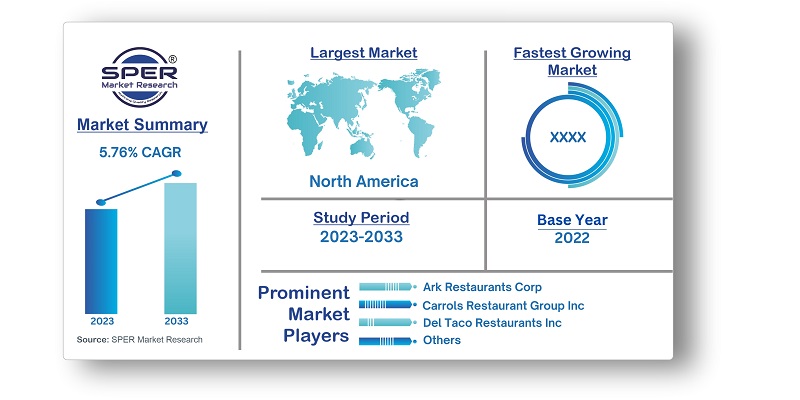
Fast Food and Quick Service Restaurant Market Growth, Size, Trends, Revenue and Future Outlook
Fast Food and Quick Service Restaurant Market Size- By Type, By Cuisine, By Service- Regional Outlook, Competitive Strategies and Segment Forecast to 2033
| Published: Dec-2023 | Report ID: FOOD23101 | Pages: 1 - 155 | Formats*: |
| Category : Food & Beverages | |||
- 2023: McDonald's and Glovo signed a long-term strategic partnership in May 2023 to enhance the customer experience. The company wanted to give customers more options and choices on the platform and improve their experience ordering Mc Delivery through the Glovo platform.
- 2023: Jollibee Foods Corp. announced in March 2023 that it would add up to 600 new locations by the end of the year to increase its global footprint.


| Report Metric | Details |
| Market size available for years | 2019-2033 |
| Base year considered | 2022 |
| Forecast period | 2023-2033 |
| Segments covered | By Type, By Cuisine, By Service |
| Regions covered | North America, Asia-Pacific, Latin America, Middle East & Africa and Europe |
| Companies Covered | Ark Restaurants Corp., Carrols Restaurant Group Inc., Chipotle Mexican Grill Inc., Del Taco Restaurants Inc., Jack in The Box Inc., Kotipizza Group Oyj (Orkla ASA), McDonald's Corporation, Restaurant Brands International Inc., The Wendy's Company and Yum Brands Inc. |
- Busy Professionals
- Budget-Conscious Consumers
- Families
- Health-Conscious Consumers
- Millennials and Generation Z
- Late-Night Customers
- Urban Dwellers
- Travelers and Tourists
- Tech-Savvy Consumers
- Others
| By Type: |
|
| By Cuisine: |
|
| By Service: |
|
- Global Fast Food and Quick Service Restaurant Market Size (FY’2023-FY’2033)
- Overview of Global Fast Food and Quick Service Restaurant Market
- Segmentation of Global Fast Food and Quick Service Restaurant Market By Type (Chain, Independent)
- Segmentation of Global Fast Food and Quick Service Restaurant Market By Cuisine (American, Lebanese, Turkish)
- Segmentation of Global Fast Food and Quick Service Restaurant Market By Service (Drive – Through, Eat-in, Home delivery, Takeaway)
- Statistical Snap of Global Fast Food and Quick Service Restaurant Market
- Expansion Analysis of Global Fast Food and Quick Service Restaurant Market
- Problems and Obstacles in Global Fast Food and Quick Service Restaurant Market
- Competitive Landscape in the Global Fast Food and Quick Service Restaurant Market
- Impact of COVID-19 and Demonetization on Global Fast Food and Quick Service Restaurant Market
- Details on Current Investment in Global Fast Food and Quick Service Restaurant Market
- Competitive Analysis of Global Fast Food and Quick Service Restaurant Market
- Prominent Players in the Global Fast Food and Quick Service Restaurant Market
- SWOT Analysis of Global Fast Food and Quick Service Restaurant Market
- Global Fast Food and Quick Service Restaurant Market Future Outlook and Projections (FY’2023-FY’2033)
- Recommendations from Analyst
1.1. Scope of the report1.2. Market segment analysis
2.1. Research data source
2.1.1. Secondary Data2.1.2. Primary Data2.1.3. SPER’s internal database2.1.4. Premium insight from KOL’s
2.2. Market size estimation
2.2.1. Top-down and Bottom-up approach
2.3. Data triangulation
4.1. Driver, Restraint, Opportunity and Challenges analysis
4.1.1. Drivers4.1.2. Restraints4.1.3. Opportunities4.1.4. Challenges
4.2. COVID-19 Impacts of the Global Fast Food and Quick Service Restaurant Market
5.1. SWOT Analysis
5.1.1. Strengths5.1.2. Weaknesses5.1.3. Opportunities5.1.4. Threats
5.2. PESTEL Analysis
5.2.1. Political Landscape5.2.2. Economic Landscape5.2.3. Social Landscape5.2.4. Technological Landscape5.2.5. Environmental Landscape5.2.6. Legal Landscape
5.3. PORTER’s Five Forces
5.3.1. Bargaining power of suppliers5.3.2. Bargaining power of buyers5.3.3. Threat of Substitute5.3.4. Threat of new entrant5.3.5. Competitive rivalry
5.4. Heat Map Analysis
6.1. Global Fast Food and Quick Service Restaurant Market Manufacturing Base Distribution, Sales Area, Product Type6.2. Mergers & Acquisitions, Partnerships, Product Launch, and Collaboration in Global Fast Food and Quick Service Restaurant Market
7.1. Global Fast Food and Quick Service Restaurant Market Value Share and Forecast, By Type, 2023-20337.2. Chain7.3. Independent
8.1. Global Fast Food and Quick Service Restaurant Market Value Share and Forecast, By Cuisine, 2023-20338.2. American8.3. Lebanese8.4. Turkish
9.1. Global Fast Food and Quick Service Restaurant Market Value Share and Forecast, By Service, 2023-20339.2. Drive- Through9.3. Eat- In9.4. Home Delivery9.5. Takeaway
10.1. Global Fast Food and Quick Service Restaurant Market Size and Market Share
11.1. Global Fast Food and Quick Service Restaurant Market Size and Market Share By Type (2019-2026)11.2. Global Fast Food and Quick Service Restaurant Market Size and Market Share By Type (2027-2033)
12.1. Global Fast Food and Quick Service Restaurant Market Size and Market Share By Cuisine (2019-2026)12.2. Global Fast Food and Quick Service Restaurant Market Size and Market Share By Cuisine (2027-2033)
13.1. Global Fast Food and Quick Service Restaurant Market Size and Market Share By Service (2019-2026)13.2. Global Fast Food and Quick Service Restaurant Market Size and Market Share By Service (2027-2033)
14.1. Global Fast Food and Quick Service Restaurant Market Size and Market Share By Region (2019-2026)14.2. Global Fast Food and Quick Service Restaurant Market Size and Market Share By Region (2027-2033)
14.3. Asia-Pacific
14.3.1. Australia14.3.2. China14.3.3. India14.3.4. Japan14.3.5. South Korea14.3.6. Rest of Asia-Pacific
14.4. Europe
14.4.1. France14.4.2. Germany14.4.3. Italy14.4.4. Spain14.4.5. United Kingdom14.4.6. Rest of Europe
14.5. Middle East and Africa
14.5.1. Kingdom of Saudi Arabia
14.5.2. United Arab Emirates14.5.3. Rest of Middle East & Africa
14.6. North America
14.6.1. Canada14.6.2. Mexico14.6.3. United States
14.7. Latin America
14.7.1. Argentina14.7.2. Brazil14.7.3. Rest of Latin America
15.1. Ark Restaurants Corp
15.1.1. Company details15.1.2. Financial outlook15.1.3. Product summary15.1.4. Recent developments
15.2. Carrols Restaurants Group Inc.
15.2.1. Company details
15.2.2. Financial outlook15.2.3. Product summary15.2.4. Recent developments
15.3. Chipotle Mexican Grill Inc.
15.3.1. Company details15.3.2. Financial outlook15.3.3. Product summary15.3.4. Recent developments
15.4. Del Taco Restaurants Inc.
15.4.1. Company details15.4.2. Financial outlook15.4.3. Product summary15.4.4. Recent developments
15.5. Jack in the Box Inc.
15.5.1. Company details15.5.2. Financial outlook15.5.3. Product summary15.5.4. Recent developments
15.6. Kotipizza Group Oyj
15.6.1. Company details15.6.2. Financial outlook15.6.3. Product summary15.6.4. Recent developments
15.7. McDonald’s Corporation
15.7.1. Company details15.7.2. Financial outlook15.7.3. Product summary15.7.4. Recent developments
15.8. The Wendy’s Company
15.8.1. Company details15.8.2. Financial outlook15.8.3. Product summary15.8.4. Recent developments
15.9. Yum Brands
15.9.1. Company details15.9.2. Financial outlook15.9.3. Product summary15.9.4. Recent developments
15.10. Others
SPER Market Research’s methodology uses great emphasis on primary research to ensure that the market intelligence insights are up to date, reliable and accurate. Primary interviews are done with players involved in each phase of a supply chain to analyze the market forecasting. The secondary research method is used to help you fully understand how the future markets and the spending patterns look likes.
The report is based on in-depth qualitative and quantitative analysis of the Product Market. The quantitative analysis involves the application of various projection and sampling techniques. The qualitative analysis involves primary interviews, surveys, and vendor briefings. The data gathered as a result of these processes are validated through experts opinion. Our research methodology entails an ideal mixture of primary and secondary initiatives.



Frequently Asked Questions About This Report
PLACE AN ORDER
Year End Discount
Sample Report
Pre-Purchase Inquiry
NEED CUSTOMIZATION?
Request CustomizationCALL OR EMAIL US
100% Secure Payment






Related Reports
Our Global Clients
Our data-driven insights have influenced the strategy of 200+ reputed companies across the globe.




















